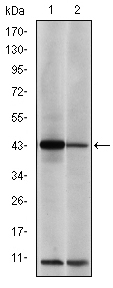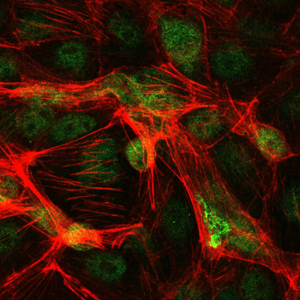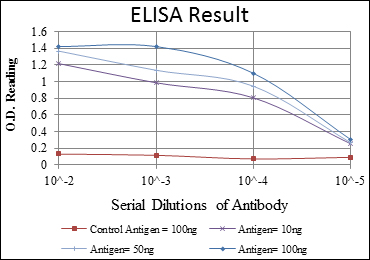AP-1 Monoclonal Antibody
- Catalog No.:YM0027
- Applications:WB;IHC;IF;FCM;ELISA
- Reactivity:Human;Mouse;Monkey
- Target:
- c-JUN
- Fields:
- >>Endocrine resistance;>>MAPK signaling pathway;>>ErbB signaling pathway;>>cAMP signaling pathway;>>Mitophagy - animal;>>Apoptosis;>>Wnt signaling pathway;>>Osteoclast differentiation;>>Focal adhesion;>>Tight junction;>>Toll-like receptor signaling pathway;>>NOD-like receptor signaling pathway;>>C-type lectin receptor signaling pathway;>>IL-17 signaling pathway;>>Th1 and Th2 cell differentiation;>>Th17 cell differentiation;>>T cell receptor signaling pathway;>>B cell receptor signaling pathway;>>TNF signaling pathway;>>Neurotrophin signaling pathway;>>GnRH signaling pathway;>>Estrogen signaling pathway;>>Oxytocin signaling pathway;>>Relaxin signaling pathway;>>Non-alcoholic fatty liver disease;>>AGE-RAGE signaling pathway in diabetic complications;>>Cocaine addiction;>>Amphetamine addiction;>>Epithelial cell signaling in Helicobacter pylori infection;>>Pathogenic Escherichia coli infection;>>Shigellosis;>>Salmonella infection;>>Pertussis;>>Yersinia infection;>>Leishmaniasis;>>Chagas di
- Gene Name:
- JUN
- Protein Name:
- Transcription factor AP-1;jun;c-jun;AP-1
- Human Gene Id:
- 3725
- Human Swiss Prot No:
- P05412
- Mouse Gene Id:
- 16476
- Mouse Swiss Prot No:
- P05627
- Immunogen:
- Purified recombinant fragment of human AP-1 expressed in E. Coli.
- Specificity:
- AP-1 Monoclonal Antibody detects endogenous levels of AP-1 protein.
- Formulation:
- Liquid in PBS containing 50% glycerol, 0.5% BSA and 0.02% sodium azide.
- Source:
- Monoclonal, Mouse
- Dilution:
- WB 1:500 - 1:2000. IHC 1:200 - 1:1000. IF 1:200 - 1:1000. Flow cytometry: 1:200 - 1:400. ELISA: 1:10000. Not yet tested in other applications.
- Purification:
- Affinity purification
- Storage Stability:
- -15°C to -25°C/1 year(Do not lower than -25°C)
- Other Name:
- JUN;Transcription factor AP-1;Activator protein 1;AP1;Proto-oncogene c-Jun;V-jun avian sarcoma virus 17 oncogene homolog;p39
- Observed Band(KD):
- 39-42kD
- References:
- 1. J Biol Chem. 2010 Mar 12;285(11):8218-26.
2. Mol Cancer. 2010 May 19;9:111.
- Background:
- This gene is the putative transforming gene of avian sarcoma virus 17. It encodes a protein which is highly similar to the viral protein, and which interacts directly with specific target DNA sequences to regulate gene expression. This gene is intronless and is mapped to 1p32-p31, a chromosomal region involved in both translocations and deletions in human malignancies. [provided by RefSeq, Jul 2008],
- Function:
- function:Transcription factor that recognizes and binds to the enhancer heptamer motif 5'-TGA[CG]TCA-3'.,PTM:Phosphorylation enhances the transcriptional activity. Phosphorylated by PRKDC.,similarity:Belongs to the bZIP family.,similarity:Belongs to the bZIP family. Jun subfamily.,similarity:Contains 1 bZIP domain.,subunit:Heterodimer with either FOS or BATF3. Interacts with HIVEP3 (By similarity). Interacts with SMAD3/SMAD4 heterodimers. Interacts with MYBBP1A, SPIB and TCF20. Interacts with COPS5; indirectly leading to its phosphorylation. Interacts with DSIPI; this interaction inhibits the binding of active AP1 to its target DNA.,
- Subcellular Location:
- Nucleus.
- Expression:
- Expressed in the developing and adult prostate and prostate cancer cells.
PANX1-mediated ATP release confers FAM3A’s suppression effects on hepatic gluconeogenesis and lipogenesis Military Medical Research Hu Cheng-Qing WB Mouse hepatocytes
- June 19-2018
- WESTERN IMMUNOBLOTTING PROTOCOL
- June 19-2018
- IMMUNOHISTOCHEMISTRY-PARAFFIN PROTOCOL
- June 19-2018
- IMMUNOFLUORESCENCE PROTOCOL
- September 08-2020
- FLOW-CYTOMEYRT-PROTOCOL
- May 20-2022
- Cell-Based ELISA│解您多样本WB检测之困扰
- July 13-2018
- CELL-BASED-ELISA-PROTOCOL-FOR-ACETYL-PROTEIN
- July 13-2018
- CELL-BASED-ELISA-PROTOCOL-FOR-PHOSPHO-PROTEIN
- July 13-2018
- Antibody-FAQs
- Products Images

- Western Blot analysis using AP-1 Monoclonal Antibody against NIH/3T3 (1) and Cos7 (2) cell lysate.

- Immunohistochemistry analysis of paraffin-embedded human intima canncer tissues with DAB staining using AP-1 Monoclonal Antibody.

- Immunofluorescence analysis of PC-2 cells using AP-1 Monoclonal Antibody (green). Red: Actin filaments have been labeled with Alexa Fluor-555 phalloidin.

- Flow cytometric analysis of HepG2 cells using AP-1 Monoclonal Antibody (blue) and negative control (red).




